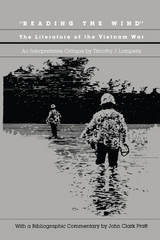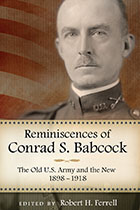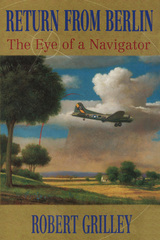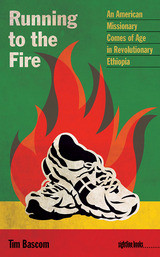113 books about Personal narratives, American and 5
start with R
113 books about Personal narratives, American and 5
113 books about Personal narratives, American
5 start with R start with R
5 start with R start with R

Rattler One-Seven
A Vietnam Helicopter Pilot's War Story
Chuck Gross
University of North Texas Press, 2004

Reading the Wind
The Literature of the Vietnam War
Timothy J. Lomperis
Duke University Press, 1987
The decade following the American defeat in Vietnam has been filled with doubts about American politics and values, confusion over the lessons of the war, and anger about the physical and psychological suffering that occurred during the war as well as thereafter. In the years since the U.S. withdrawal, our need to make sense of Vietnam has prompted an outpouring of thinking and writing, from scholarly reappraisals of American foreign policy to highly personal accounts of participants. On the tenth anniversary of the final U. S. withdrawal, the Asia Society sponsored a conference on the Vietnam experience in American literature at which leading writers, critics, publishers, commentators, and academics wrestled with this phenomenon. Drawing on the synergy of this conference, Timothy J. Lomperis has produced an original work that focuses on the growing body of literature—including novels, personal accounts, and oral histories—which describes the experiences of American soldiers in Vietnam as well as the experience of veterans upon their return home.
[more]

Reminiscences of Conrad S. Babcock
The Old U.S. Army and the New, 1898-1918
Edited by Robert H. Ferrell
University of Missouri Press, 2012
The son of an army officer, Conrad S. Babcock graduated from West Point in 1898, just in time for the opening of the Spanish-American War. Because of his father’s position, he managed to secure a place in the force that Major General Wesley Merritt led to Manila to secure the city. The Philippine Insurrection, as Americans described it, began shortly after he arrived. What Babcock observed in subsequent months and years, and details in his memoir, was the remarkable transition the U.S. Army was undergoing. From after the Civil War until just before the Spanish War, the army amounted to 28,000 men. It increased to 125,000, tiny compared with those of the great European nations of France and Germany, but the great change in the army came after its arrival in France in the summer of 1918, when the German army compelled the U.S. to change its nineteenth-century tactics.
Babcock’s original manuscript has been shortened by Robert H. Ferrell into eight chapters which illustrate the tremendous shift in warfare in the years surrounding the turn of the century. The first part of the book describes small actions against Filipinos and such assignments as taking a cavalry troop into the fire-destroyed city of San Francisco in 1906 or duty in the vicinity of Yuma in Arizona when border troubles were heating up with brigands and regular troops. The remaining chapters, beginning in 1918, set out the battles of Soissons (July 18–22) and Saint-Mihiel (September 12–16) and especially the immense battle of the Meuse-Argonne (September 26–November 11), the largest (1.2 million troops involved) and deadliest (26,000 men killed) battle in all of American history.
By the end of his career, Babcock was an adroit battle commander and an astute observer of military operations. Unlike most other officers around him, he showed an ability and willingness to adapt infantry tactics in the face of recently developed technology and weaponry such as the machine gun. When he retired in 1937 and began to write his memoirs, another world war had begun, giving additional context to his observations about the army and combat over the preceding forty years.
Until now, Babcock’s account has only been available in the archives of the Hoover Institution, but with the help of Ferrell's crisp, expert editing, this record of army culture in the first decades of the twentieth century can now reach a new generation of scholars.
[more]

Return from Berlin
The Eye of a Navigator
Robert Grilley
University of Wisconsin Press, 2003
During the summer of 1944, the now-legendary American Eighth Air Force was engaged in a ferocious air battle over Europe to bring the Allies victory over the German Third Reich. This is the story of one B-17 navigator and his crewmates, men who faced extraordinary danger with a maturity beyond their years. This vivid and detailed account of combat flying and its psychological toll also recalls the beginning of Robert Grilley’s development as a painter of international renown, as he spends his off-duty time drawing the peaceful Northamptonshire landscape around Deenethorpe airbase.
Wakened with flashlights on their faces in the predawn hours, he and his crew repeatedly face the Luftwaffe in battles five miles high, flying through flak "so thick you could get out and walk on it." Stretching their stamina to the limits, they succeed time after time in their missions to bomb munitions works, railyards, the Leüna synthetic oil plant at Merseburg in eastern Germany, the V2 rocket research center at Peenemünde on the distant Baltic Coast, and even to strike Hitler’s capital city, Berlin.
But Grilley finds interludes of unexpected grace and restoration on his days off, making serious drawings from nature at the neighboring Yokehill Farm. There he slowly cultivates a friendship with a curious eight-year-old, the lively child Elizabeth, who becomes for the combat flyer a symbol of survival.
Wakened with flashlights on their faces in the predawn hours, he and his crew repeatedly face the Luftwaffe in battles five miles high, flying through flak "so thick you could get out and walk on it." Stretching their stamina to the limits, they succeed time after time in their missions to bomb munitions works, railyards, the Leüna synthetic oil plant at Merseburg in eastern Germany, the V2 rocket research center at Peenemünde on the distant Baltic Coast, and even to strike Hitler’s capital city, Berlin.
But Grilley finds interludes of unexpected grace and restoration on his days off, making serious drawings from nature at the neighboring Yokehill Farm. There he slowly cultivates a friendship with a curious eight-year-old, the lively child Elizabeth, who becomes for the combat flyer a symbol of survival.
[more]

Running to the Fire
An American Missionary Comes of Age in Revolutionary Ethiopia
Tim Bascom
University of Iowa Press, 2015
In the streets of Addis Ababa in 1977, shop-front posters illustrate Uncle Sam being strangled by an Ethiopian revolutionary, parliamentary leaders are executed, student protesters are gunned down, and Christian mission converts are targeted as imperialistic sympathizers. Into this world arrives sixteen-year-old Tim Bascom, whose missionary parents have brought their family from a small town in Kansas straight into Colonel Mengistu’s Marxist “Red Terror.” Here they plan to work alongside a tiny remnant of western missionaries who trust that God will somehow keep them safe.
Running to the Fire focuses on the turbulent year the Bascom family experienced upon traveling into revolutionary Ethiopia. The teenage Bascom finds a paradoxical exhilaration in living so close to constant danger. At boarding school in Addis Ababa, where dorm parents demand morning devotions and forbid dancing, Bascom bonds with other youth due to a shared sense of threat. He falls in love for the first time, but the young couple is soon separated by the politics that affect all their lives. Across the country, missionaries are being held under house arrest while communist cadres seize their hospitals and schools. A friend’s father is imprisoned as a suspected CIA agent; another is killed by raiding Somalis.
Throughout, the teenaged Bascom struggles with his faith and his role within the conflict as a white American Christian missionary’s child. Reflecting back as an adult, he explores the historical, cultural, and religious contexts that led to this conflict, even though in doing so he is forced to ask himself questions that are easier left alone. Why, he wonders, did he find such strange fulfillment in being young and idealistic in the middle of what was essentially a kind of holy war?
Running to the Fire focuses on the turbulent year the Bascom family experienced upon traveling into revolutionary Ethiopia. The teenage Bascom finds a paradoxical exhilaration in living so close to constant danger. At boarding school in Addis Ababa, where dorm parents demand morning devotions and forbid dancing, Bascom bonds with other youth due to a shared sense of threat. He falls in love for the first time, but the young couple is soon separated by the politics that affect all their lives. Across the country, missionaries are being held under house arrest while communist cadres seize their hospitals and schools. A friend’s father is imprisoned as a suspected CIA agent; another is killed by raiding Somalis.
Throughout, the teenaged Bascom struggles with his faith and his role within the conflict as a white American Christian missionary’s child. Reflecting back as an adult, he explores the historical, cultural, and religious contexts that led to this conflict, even though in doing so he is forced to ask himself questions that are easier left alone. Why, he wonders, did he find such strange fulfillment in being young and idealistic in the middle of what was essentially a kind of holy war?
[more]
READERS
Browse our collection.
PUBLISHERS
See BiblioVault's publisher services.
STUDENT SERVICES
Files for college accessibility offices.
UChicago Accessibility Resources
home | accessibility | search | about | contact us
BiblioVault ® 2001 - 2024
The University of Chicago Press









